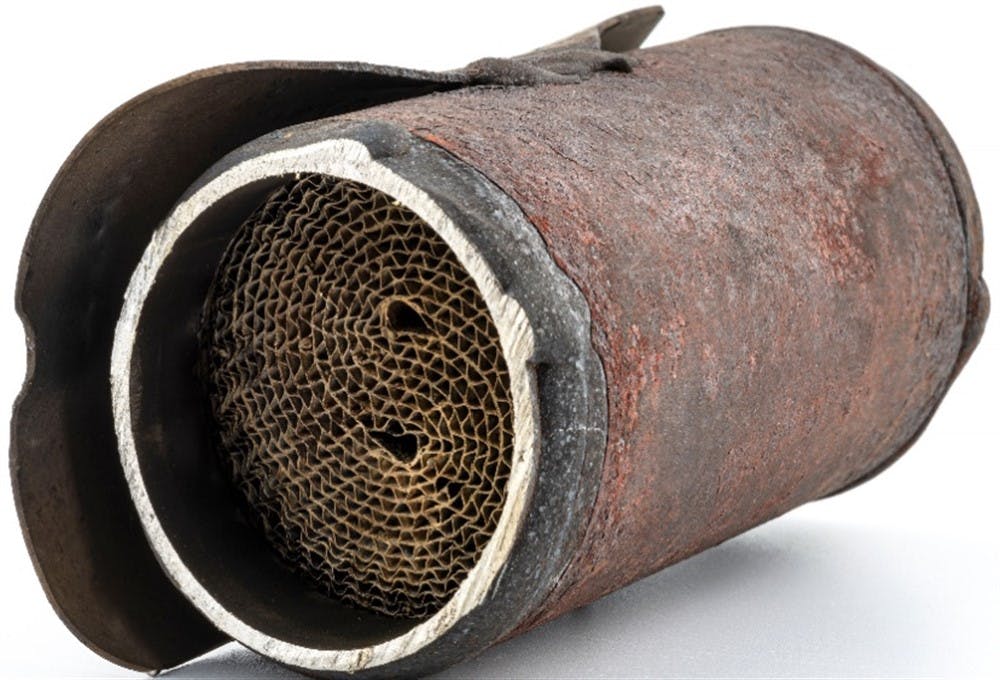How Does a Diesel Particulate Filter Work?

In its simplest form, a DPF is just a metal canister that encloses a porous core, the porosity being required to allow soot-laden diesel exhaust to flow through the core, which captures and retains the soot until it can be oxidised, or burned off in a regeneration event when the soot load reaches a predefined level.
Unfortunately, limited space precludes a comprehensive discussion of the highly complex chemical reactions and interactions between diesel soot and the various catalytic materials in modern DPF devices, but suffice it to say that the catalytic materials in modern DPFs reduce both the duration and oxidation temperature of regeneration events. For instance, while the temperature required for oxidation of diesel soot in an un-catalysed DPF is typically between about 550 and 650 degrees Celsius, this temperature is reduced to about 400 degrees Celsius in a catalysed DPF, and the duration of a passive regeneration event is reduced by about 50%.
In terms of operating principles, the process f capturing diesel soot particles is continuous while a diesel engine is running, but as might be expected, continuously trapping diesel soot particles will eventually lead to a situation where the accumulated soot particles clog up the core of a DPF completely unless the accumulated soot is removed periodically. The process of removing soot from the core is, therefore, necessary to clean out a DPF to restore its ability to trap and contain soot particles until the next regeneration event occurs.
As a practical matter, DPF regeneration events come in two “flavours”; active and passive, and in both cases, the frequency and completeness of regeneration events determine both the longevity and efficiency of a DPF during its useful life. Let us look at these processes in some detail, starting with-
Passive regeneration
This regeneration process occurs aromatically, subject to strictly defined enabling conditions being met. These include having driven a specific distance since the last generation event, a sustained period of driving at a predefined road speed, and having completed a set number of drive cycles, as opposed to trips, since the last regeneration event.
These conditions are all based on a) how modern engine control modules estimate the load of soot that will likely be accumulated since the last generation event and b) the exhaust back pressure level as reported by the DPF pressure sensors, or by the temperature of the exhaust gas as it leaves the DPF.
Assuming that all enabling conditions are met, the temperature of the exhaust gas will periodically, and automatically, rise sufficiently to “light off” the DPF, meaning that the process of burning off the accumulated soot load will initiate and complete without any inputs or actions from the driver or any control module being required.
Note though that sustained operation of a diesel vehicle in conditions that do not allow the exhaust gas temperature to reach the “lighting off” point, such as sustained driving in city traffic will rarely (if ever) result in DPF regeneration events, which will greatly reduce the useful life of a DPF.
Active regeneration
In this context, the word "active" refers to a specific action or set of actions that one or more control modules perform to initiate a DPF regeneration event. These actions typically involve a control module injecting a small amount of raw fuel into the DPF, and then raising the exhaust temperature via one or more additional strategies to ignite the fuel in the DPF to burn off the accumulated soot. The most common method of raising the exhaust temperature to the required level is to manipulate the timing of fuel injection events to allow some fuel to combust in the exhaust manifold.
Nonetheless, an active regeneration event will only occur under strictly defined conditions. These include a reported DPF efficiency level that falls below a minimum allowable threshold, a sustained high engine speed, and a specified engine load/ throttle opening that will not cause the DPF regeneration process to end prematurely.
This last condition is based on the time the engine control module estimates the regeneration process requires to complete; thus, if the engine speed and load are not sustained for a specified period, the engine control module will not initiate a regeneration event to avoid the possibility of the process not running to completion.
Note that as a general rule of thumb, both passive and active regeneration events can take between about 10 minutes and about 20 minutes to complete, during which time the following signs that a generation event is underway may be noticeable-
- Stop & Go functionality (if fitted) will be deactivated.
- The radiator cooling fan(s) may be running at full speed although the engine’s temperature may be normal or slightly below normal.
- The idling speed may increase for a short period after a regeneration event has run to completion.
- The engine or exhaust note may change perceptibly
- A strong smell of exhaust gas may be present while the regeneration event is underway
Note though that the absence of any of the above possible signs does not necessarily mean that the vehicle has stopped initiating DPF regeneration events because the intensity of the listed "symptoms" is largely vehicle make and model-specific. If fact, DPF regeneration events on many modern high-end diesel vehicles are so efficient that the driver or occupants of such vehicles may never notice that DPF regenerations are occurring at all.
